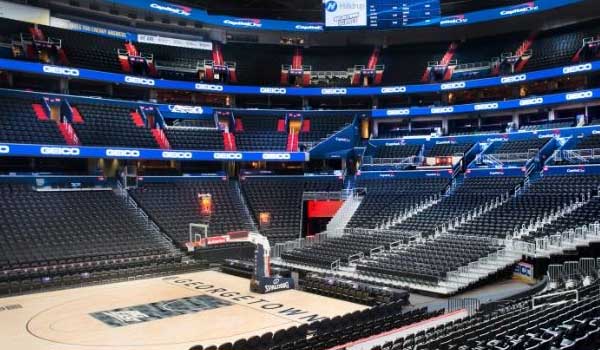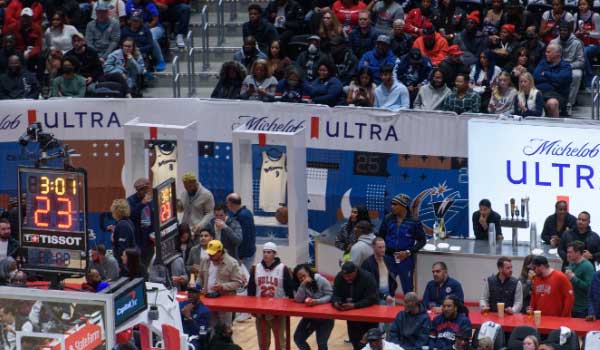| |
Part Four: The Main Event

In college basketball, home is where the heart is. Two generations of administrative indifference leave Georgetown basketball a place that is a house but not a home; and of late, an empty one at that.
Ed Cooley arrived at Georgetown University from a school which made a generic downtown arena its home, and with it, a 31-3 record over the past two seasons: the same record as Duke from 2021 to 2023. The Big East's version of a Taylor Swift concert sold 180,330 tickets for the Fightin' Friars last season and has announced this spring it has sold out all games for the 2023-24 season.
Back in Washington, a free ticket giveaway for the opener drew 7,125 and was the second largest crowd of the season. Losing has that effect, of course, but under any name, Capital One Arena doesn't stir the passion for college basketball as its peers do.
Yes, better scheduling would help. Games with a reconstituted Syracuse team and TCU are not the stuff of demand, and fans are not likely to find much better when the schedule is released. Yes, playing big games at a time other than 12 noon might be preferable, but Fox Sports and the arena's NBA and NHL priorities offer little room in that department. A new look inside the bowl would help, but this too is out of Georgetown's hands.
Change must start with attitude. The fan base must make home court attendance a priority, and in concert, Georgetown must iterate the fan experience beyond, say, 1989. The cheerleaders (which used to be coed, by the way) do very little cheering nowadays. The band remains locked into music that fans of the 1980s are familiar with--not because the songs are of the 80s, but because they were playing the same songs then. A dance team, seen at every other Big East school but Georgetown, has been absent for over two decades.
When they are given the opportunity, students in attendance can be a great asset, even if arena security sometime looks at them as if they are combatants. For the most part, students have been less organized than in the past, as groups like Hoya Blue never recovered from the COVID break and organized in-game support seems entirely lacking. As to the adults in the room, well, it's a very reserved bunch, because rowdy crowds were never part of the ethos and culture going back to when Georgetown moved in a quarter century ago. No road opponent worries too much about a game in Washington.
In short, Georgetown has become a disinterested fan base, and a home court advantage at Capital One Arena has been as likely as it is has at FedEx Field in recent years. But this not only can change, it has to.
Attending a game is as much a community exercise as the game itself. With that, three areas for immediate improvement:
1. Give people gathering areas for the game. Capital One Arena is certainly more fan friendly than its predecessor arena, but the sheer combination of activities outside its walls leads many to adopt what the accountants used to call a LIFO approach to arrival and departure: last in, first out. The design of Capital One Arena leaves little or no room for people to congregate before a game and its club areas are either unknown to most fans or otherwise restricted from them.
For Washington Wizards games, the arena introduced a branded court side lounge behind one of the baskets. Beer sponsorship issues notwithstanding, could a dedicated space for season ticket holders and Hoya Hoop Club members be a place for fans to meet before a game and enjoy time at halftime?

Students have no central gathering either. Events in and around the recently shuttered Gallery Place Stadium 14 theater just north of the arena offers space for fans to congregate, although that's out of the University's control. The nearby Clyde's remains a natural stop, but is less convenient for 12 noon starts. Even if the venue is not under Georgetown or Monumental Sports' control, it does not hurt advertising it, especially in the arena. Otherwise, it's arrive late and leave early.
2. Promote, promote, promote. As long as ticket supply exceeds demand, continue the outreach to offer free or sharply discounted tickets in the community - youth groups, hospitals, veterans, neighborhood groups. Give people who have never seen a Georgetown game before a means to feel welcomed and to enjoy the surroundings so they'll come back again.
It does not go unnoticed that in-game promotions have been sharply curtailed as attendance has waned. The "Gray Out" t-shirt offer once filled the entire lower bowl--in 2023, just a third of it. There are enough promotional items in the marketplace that could be considered as a incentive for fans if the goal is a more energized customer experience.
Good promotional ideas don't all go straight to the trash. In the early 1980s, a popular promotion were free painter's hats, with messages for each Big East opponent that game ("Crush The Orangemen", "Sink The Pirates", etc.) They were worn for years thereafter by students.
Which leads to the best initiative:
3. It's still all about the students. College basketball is not about the NBA experience, with piped-in rock music and feigned attempts by an on-floor announcer for people to "Get Loud!". Let students drive the intensity: let the cheerleaders cheer, let the band be heard, put students on the video boards. Retire the T-shirt cannon, the Kiss Cam, and other NBA gimmicks, and make it a more collegial environment.
In the last part of this series, a look at the new model of support.
|




